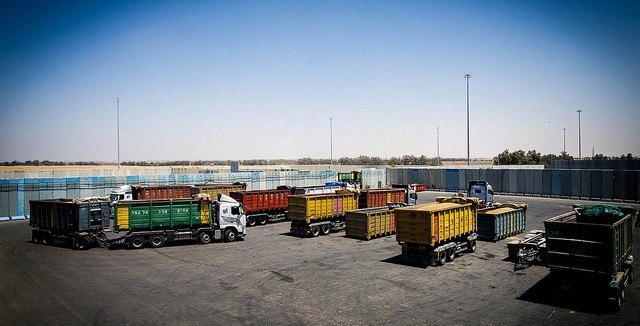On Thursday, Israel facilitated the entry of 1,000 tons of cement into the Gaza Strip, which remains the stronghold of terrorist group Hamas, according to a report by AFP. The cement entered Gaza in 175 truckloads through the Kerem Shalom border crossing and was paid for by Qatar, a strong backer of Hamas that provides the group’s political leadership safe haven within its borders.
In a statement, Israel’s Coordinator of Government Activities in the Territories (COGAT) said, “There are no fixed quantities (going in) on a daily basis. The quantities (delivered) are at the request of the Palestinian Authority in accordance with the needs of suppliers who are purchasing in Gaza.”
Between January and February, Israel permitted the passage of 9,967 truckloads of goods through the Kerem Shalom crossing. Israel administers two of the three crossings into the Gaza Strip, with Egypt controlling the third.
The current blockade on imports was imposed by Israel and Egypt in 2007, after Hamas was elected into power and violently expelled the Fatah party from the Gaza Strip. The restrictions are designed to prevent the trafficking of illegal arms and materials that could be used to construct terrorist infrastructure, including attack tunnels and weapons bunkers, within the Strip.
While Israel launched Operation Protective Edge last summer in response to Hamas’ continued rocket bombardment of southern Israel, the operation shifted midway to concentrate on the sophisticated tunnel network that snaked underneath the Gaza Strip. Estimates published in The Washington Post this past July held that Hamas built at least 36 tunnels, each with a price tag of $1 million.
Analysts said the tunnels are a major prong of Hamas’s military strategy against Israel. The IDF has sussed out 36 of what it calls “terror tunnels,” but there are probably more. While the Gaza Strip remains mired in poverty — the 2011 per capita income was $1,165 — Hamas is thought to have sunk more than $1 million into the excavation and maintenance of every tunnel. “Much to the misfortune of the people of Gaza, Hamas has invested far more resources in ‘underground Gaza’ than in ‘upper Gaza,’” wrote al-Monitor’s Shlomi Eldar. “The ‘change and reform’ that Hamas offered its voters was invested in its tunnels at the expense of the people of Gaza.”
One explosive-laden tunnel ran from a home in Gaza and opened near Kibbutz Ein Hashlosha. At the time, Defense Minister Moshe Yaalon ordered a temporary halt of construction imports to Gaza, citing the use of the materials in digging up and fortifying the tunnels.
In November, only three months after the 50-day summer war, Egyptian security sources warned that Hamas was spending $140 million annually to construct new tunnels. Many of the Palestinians involved in the construction were reportedly children. In mid-December, sources inside Gaza similarly reported to Ynet that “Hamas has been commandeering building materials from Israel transferred into the Gaza Strip for reconstruction for the purpose of rebuilding its offensive ‘terror tunnels’.”
Last month, Neri Zilber, a visiting scholar at the Washington Institute for Near East Policy, wrote:
Last September, the UN created the Gaza Reconstruction Mechanism (GRM) to ease the longstanding blockade around the enclave while allaying Israeli concerns about Hamas diverting potential dual-use materials — specifically cement — for militant ends such as tunnel construction […] According to figures made available by the PA Ministry of Civil Affairs in early January, over 42,000 individuals requiring construction materials for repairs have been cleared by the GRM, with 15,600 actually receiving materials. Moreover, through Israeli facilitation, 18,000 tons of cement have been imported into Gaza, with 15,000 tons sold to authorized individuals. In other words, as of last month there was more cement inside Gaza than could be legally bought, so the system is working and, importantly, the supply of materials is not the main impediment to reconstruction.
Rebuilding efforts in the Gaza Strip have been plagued by continued Palestinian factionalism, with Zilber stating in December that “Israel, of all the parties involved, has shown the greatest degree of flexibility towards a Gaza Strip still ruled by Hamas.”
[Photo: Flickr / The Israel Project ]




